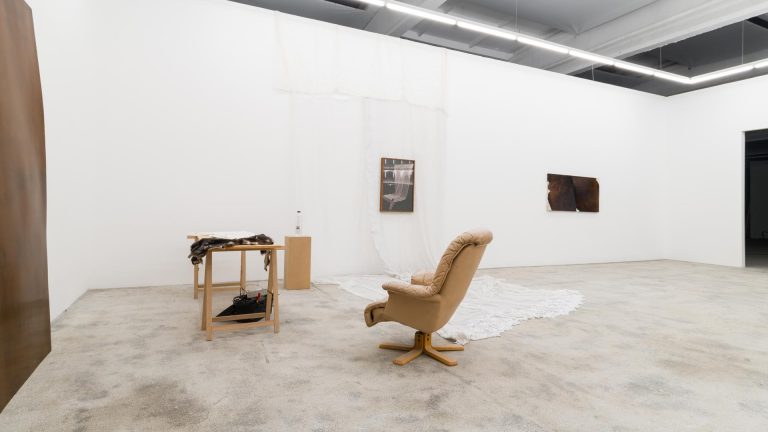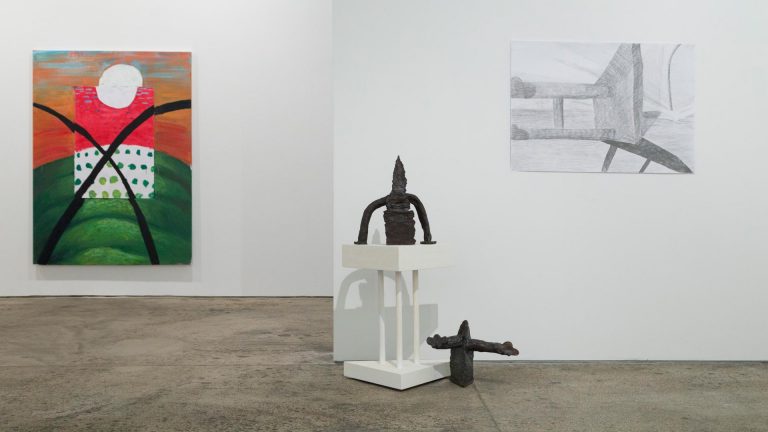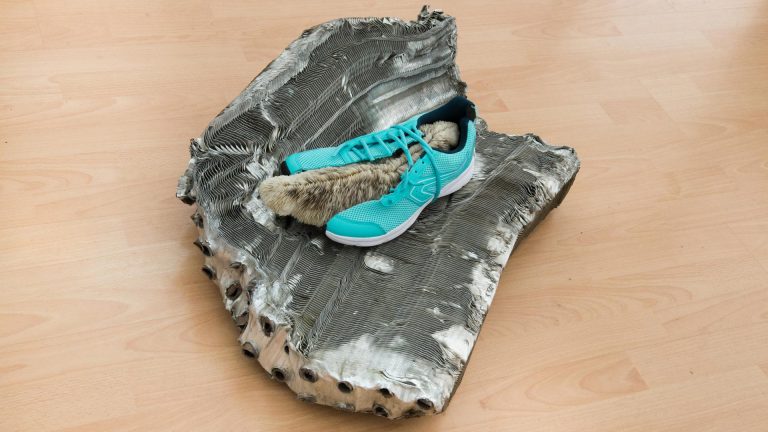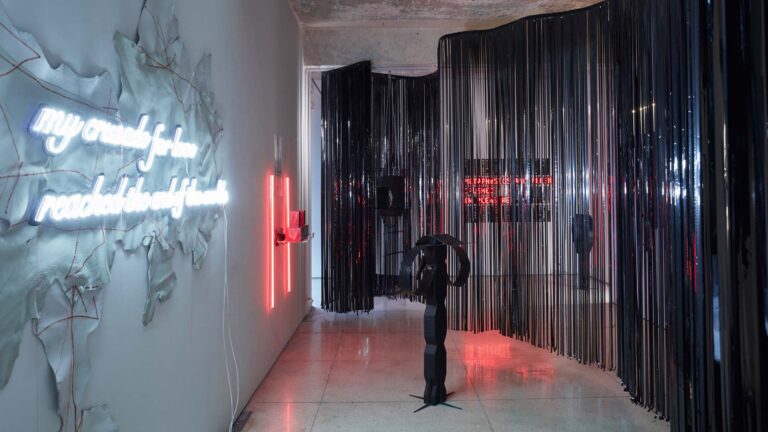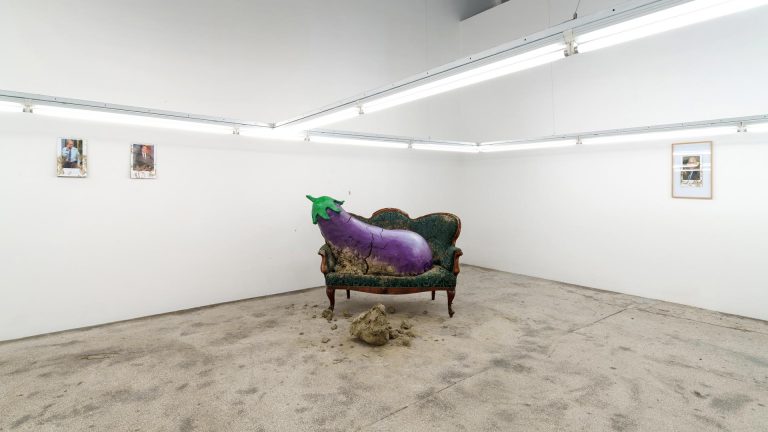Artist: Răzvan Botiș
Exhibition title: Cashmere thoughts
Venue: SABOT, Cluj-Napoca, Romania
Date: May 10 – July 25, 2016
Photography: Pavel Curagau, all images copyright and courtesy of the artist and SABOT
Glazed Goblins Galore
Visitors are kindly requested to leave no emotional baggage unattended! (Those of you unequipped with souls or ectoplasm, ignore this request.) We assume no liability for castaway psychic robes! Attention please! Fickle soul snatchers are lurking along this still life smorgasbord exhibition! Sneaky play-acting attention seekers fishing for psychic soulfood. Extreme caution is advised! Chameleon like kaolin creatures are cruising the tablecloths. Animate clay configurations hungrily seeking to take our breaths away. A momentary lapse in vigilance and they strike, urgent doctorfish with no patience, nibbling off the corners of consciousness we’re parading for them here. Their surreal existence is built on our reverent wet respirations. They sift it through their every glazed and confused pore, and break out in sparkling rainbow-colored pyrotechnic fits of vitality. Visitors are once again kindly asked to exercise empathetic caution around these creatures!
Turncoated soul sniffers. Multitudinous shapewhiffting creatuzoids. Deceptive allomorphic protoentities. Primeval playdough pals from the Eozoic. These fiends scatter their grotesquely overexaggerated humanoid features in the hope that we’ll take pity on them and lean in a little closer and perhaps breathe a little of our living souls into them. But do not yield to temptation, they are mere proto-entities of the mental cosmos. Not native to our spiritual barracks, they aren’t visitors to our everydays. Bizarre clod dreambuds. Proteiform amoebas hankering after soul-sniffets. Proto-entities living under the guise of chameleonic glazewraps. These braintwisted oddities harbor pagan spirits. Yet like us, they too are vulnerable beings looking for love. Perhaps the very reason they take shape in allochromatically colorshifting metal glazing is to infiltrate our world unnoticed. They are of the same dust and clay as us, the same ancestral alchemized humus. But unlike us, they have at least passed through a trial by fire. They parade their scars and cracks with pride. Their blazened glaze skin has come through with shed colors, their rainbow iridescence beaming coral yellow, slag brown, decayed wind-flower pink, simmering soupy azure, moldy mildew-gray and deathly white, cadaver carmine and gross green, and anointed in blighted bronze.
If in fact they fail to gather enough of our attention, enough of our stolen breath and nibbled lives, then they’ll have to resort to summoning a couple of itinerant ghosts from beyond the space-time continuum, to ensure their eventual transition to gnomity. It goes without saying that such an ordeal would have an unforeseeable impact on our civilization’s sexual-political habitat. In case even that alogical ritual should meet failure, well, they will be doomed to a state of discolorification. And in these times, who of us would want to be unglazed, an empty vessel? It seems that new-fangled man is bent on just such an endeavor, day after day, in ever growing numbers. When humanoids surrender their souls that way, there’s always a glaze goblin there to suck it on up, courtesy of the subcortex adobe kneading master Răzvan Botiş.
On the far side of purgatorial firing, these hand-formed critters tap into the Earth’s core dreams and crystallized them to their own exteriors. These sparkling iridescent surface deposits are soon wrinkled into a leathery tincture afflicted skin-glaze. It is the type of beauty the Japanese refer to as shibumi, a humble and unobtrusive beauty, effortless perfection, articulated brevity, living harmony, noble quietude, all of these promote spiritual tranquility. Japanese tea cups are glazed in honor of the volatile interplay between five basic elements (fire, water, earth, wind, and void) and the fickle forces of nature. Unwittingly perhaps, Botiş approaches his medium, namely the dancing flames of clay and metal glaze, in a similarly undirected and playful spirit.
His creatures of allomorphic substance summon up atavistic memories from beyond the ocean, the precolumbian ceramics of moche culture. Their primary features weren’t as much functional, as antropo-zoomorphic and magical. These creations of Botiş’ brain kneading had passed through the cleansing fires of alchemy and harvested the fruits of idleness. They are useless vessels for eating and drinking, serving only to nourish the spirit. To make sense of them, one must approach analogically. Like the prehistoric moche ceramics, these phantasmal coat-encrusted clayforms are unaffected by the classical canon of ideas. They have only just been brought into this world by the „arch-spirit”. They still retain a connection to the formless spirit of Nanny Earth.
Having gatecrashed our picnic, they are now mingling with our ordinary, lifeless everyday objects, no doubt doing their best to fit in. Playing the field in true harlequin style, their chameleonic mantles are mimicking the leatherette oils of our famous paintings.
These mountings aren’t scenes of any real miracles, merely the inordinately subtle infiltration of the fantastic. We are witnessing a contemporary artistic ritual, to render us into daytime dreamcatchers.
Géza Dabóczi (translation from Hungarian by Dániel Dányi)

































